Over the next couple of weeks in the run up to Christmas I wanted to talk about Fortified wines (by which I mean Sherry, Madeira and Port) as well as Dessert wines. It seems Christmas is often the only time of year when many of these wines get a run out, which I think is a bit of a shame. Hopefully these blogs will encourage a bit of experimentation and adventure.
Sherry
Anyone that only knows sherry as being that yukky sweet cream stuff you serve up to your grandmother or crusty old great-Aunt at Christmas is in for a surprise: for there is far more to this great wine of Andalucian Spain than meets the eye and it is beginning to undergo something of a resurgence, with Sherry bars popping up across London and High Street retailers beginning to offer a wide range of styles (Waitrose is particularly strong).
For sherry can be amongst the best value quality wines in the market particularly when you realise what goes into their creation: Solera Systems, Oxidative versus ageing under Flor, sweetened or unsweetened.
How they are made
I promise not to get too geeky or technical but there is some fascinating tit bits of info here that goes some way to explaining why they taste the way they do and what to look for if you do indeed decide to explore a little.
Grape Variety: predominantly Palomino (some PX is used for the sweetest style, more on this later)
Fortification process: this is the addition of a high alcohol spirit, usually highly rectified grape spirit. In the case of Sherry the spirit is added post fermentation and as a result most Sherry is naturally dry and it is the level of fortification which helps determine the style.
Lower levels of fortification (15-15.5% ABV) of wines stored in partially filled barrels allows the formation of Flor (rather ugly yeast spores which grow on the surface of the wine feeding off oxygen, alcohol and glycerine – these wines age ‘biologically’). This Flor protects the wine from oxidisation and gives them their distinctive characteristics.
The other main style of sherry is created oxidatively – by fortifying to around 18% ABV the Flor can’t survive so the wine has no protection from oxygen. As a result wines made in this way tend to turn amber or brown in colour (think what happens to an apple when you cut it open and leave it, the oxygen in the atmosphere causes the fruit to brown – it’s the same principle). These wines have a fuller body and are much deeper in colour with richer more tertiary aromas – ie less fresh fruit more dried fruit, coffee, toffee notes.
There are also wines which undergo some ageing under Flor, but this Flor for some reason ‘fails’ and dies off, meaning the wine undergo initial biological ageing followed by oxidative ageing. These have a mix of characteristics of both styles.
Solera System – in order to ensure a constant replenishment of nutrients for the Flor to live off, wines are entered into a system of barrels where the wines are effectively fractionally blended, youngest barrels feed into older barrels which feed into the oldest barrels of wine, this process can go on for years, and wines must by law be aged this way for a minimum of 2 years. This process also enables oxidatively aged wines to have a level of freshness even after many years of ageing.
I could go on but it’s probably best to get to the nitty gritty of each wine so you know what to look for.
Dry Sherry:
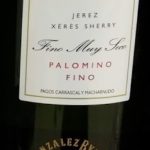 Fino – Fortified to around 15.5% ABV and aged biologically (under Flor) these wines are some of the lightest styles of sherry and also the driest. Example brand: Tio Pepe
Fino – Fortified to around 15.5% ABV and aged biologically (under Flor) these wines are some of the lightest styles of sherry and also the driest. Example brand: Tio Pepe
Key characteristics: bone dry, very light in body, pale lemon colour with almond, yeasty, bruised apple notes.
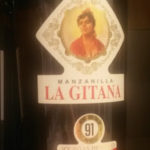 Manzanilla – Another type of Fino, but this one is only made in a specific coastal region of Jerez called Sanlucar de Barrameda. Brands include La Gitana
Manzanilla – Another type of Fino, but this one is only made in a specific coastal region of Jerez called Sanlucar de Barrameda. Brands include La Gitana
Key characteristics: Stylistically similar to Fino in colour and body, the main difference is that alongside the nutty notes these wines tend to have more floral characteristics (Camomile) alongside a touch of saltiness.
Both of the above wine styles are lovely served chilled alongside olives and salted almonds.
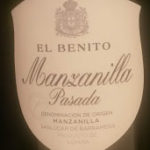 **Note – you may find bottles which are called Manzanilla Pasada, this is an older Manzanilla where the flor has died off with age hence the wine exhibits some oxidative characteristics. A halfway house if you like between a Manzanilla and an Amontillado**
**Note – you may find bottles which are called Manzanilla Pasada, this is an older Manzanilla where the flor has died off with age hence the wine exhibits some oxidative characteristics. A halfway house if you like between a Manzanilla and an Amontillado**
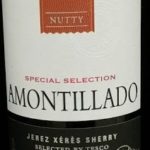 Amontillado – This is effectively an aged Fino, The wine starts out as a Fino but when the flor dies over time, the wine is exposed to oxygen and as such develops oxidative characteristics.
Amontillado – This is effectively an aged Fino, The wine starts out as a Fino but when the flor dies over time, the wine is exposed to oxygen and as such develops oxidative characteristics.
Key characteristics: Dry but fuller in body and deeper in colour (but not as deep as Oloroso or PX) and nuttier than Fino’s, these wines are also higher alcohol with flavour characteristics including hazelnut and tobacco.
Palo Cortado – the rarest of all Sherries and somewhat mythical! Its formation is trickier to explain so I won’t, other than to say it begins life as a Fino but develops special characteristics when its Flor dies off so is refortified to 18% ABV and then ages oxidatively. Its best described as having an Amontillado nose with the body and flavour profile similar to an Oloroso and often noticeable lactic (vanilla/creamy characteristics). Note in reality can be made artificially (by blending Oloroso and Amontillado) but these won’t have the complexities of the naturally produced wine.
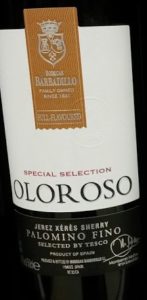 Oloroso – only oxidatively aged, these wines are richer and higher in alcohol than the wines mentioned earlier. The colour ranges from amber to a deep brown and the wines exhibit caramelized, toasty and spicy notes and noticeable walnut aromas. All in all a more powerful wine with a lovely long aftertaste, I’m a fan of this style, they are generally dry but may have a hint of sweetness. This is something which could work with cheeses.
Oloroso – only oxidatively aged, these wines are richer and higher in alcohol than the wines mentioned earlier. The colour ranges from amber to a deep brown and the wines exhibit caramelized, toasty and spicy notes and noticeable walnut aromas. All in all a more powerful wine with a lovely long aftertaste, I’m a fan of this style, they are generally dry but may have a hint of sweetness. This is something which could work with cheeses.
Blended Sweetened sherry:
More commonly known as Cream Sherries which are perhaps the ones many of you (or your aforementioned grannies and great aunts!) are most aware of…think Harvey’s Bristol Cream.
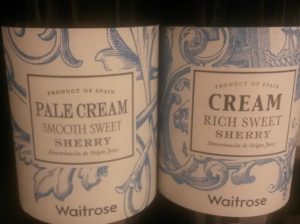 These come in 3 main styles: Pale Cream, Medium Cream or Cream and vary in appearance and style although the one thing in common is sweetness as all of these originally dry wines will have had sweetness artificially added: better quality wines through the addition of sweet wine (ie PX), cheaper versions using substances like Arrope (the syrup of Rectified Concentrated Grape Must) – sounds lovely right?
These come in 3 main styles: Pale Cream, Medium Cream or Cream and vary in appearance and style although the one thing in common is sweetness as all of these originally dry wines will have had sweetness artificially added: better quality wines through the addition of sweet wine (ie PX), cheaper versions using substances like Arrope (the syrup of Rectified Concentrated Grape Must) – sounds lovely right?
This is not to say they are all bad there really are some pretty good premium examples, but the cheaper ones you see in the supermarket will generally have been made by the latter process mentioned above.
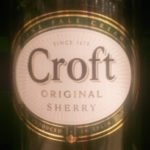 Pale Cream – ie Croft Original. These are sweetened Fino’s so have typical Fino characteristics (remember: almond, yeasty, quite light and fresh) alongside some sweetness and as the name suggests are paler in colour. If labelled as Pale Dry Cream – it can have up to 45g residual sugar so be warned it won’t be dry but is drier than most Pale Creams!
Pale Cream – ie Croft Original. These are sweetened Fino’s so have typical Fino characteristics (remember: almond, yeasty, quite light and fresh) alongside some sweetness and as the name suggests are paler in colour. If labelled as Pale Dry Cream – it can have up to 45g residual sugar so be warned it won’t be dry but is drier than most Pale Creams!
Medium Cream – these are sweetened Amontillado’s so are noticeably darker in colour than Pale Cream, richer in style and higher in alcohol. Sweetness levels vary if you see Medium Dry it can have similar sweetness levels to a Pale Dry Cream, if Medium Sweet then it will be a lot sweeter.
 Cream – ie Harvey’s Bristol Cream. The deepest colour and fullest body of the cream sherries and the sweetest style, often quite syrupy. Usually sweetened Oloroso hence the walnut, caramel characteristics combined with a fair amount of sugar!
Cream – ie Harvey’s Bristol Cream. The deepest colour and fullest body of the cream sherries and the sweetest style, often quite syrupy. Usually sweetened Oloroso hence the walnut, caramel characteristics combined with a fair amount of sugar!
I wouldn’t pair any of these cream sherries with anything savoury (save perhaps stronger cheese). Served chilled they could work as an aperitif but may murder your palate before dinner! Probably best with fruit based deserts, I don’t really enjoy these styles but if you have a sweeter tooth as an entry into the styles of sherry they work but pick a better quality one not the £6 quid versions you see in the supermarkets…after all you get what you pay for.
Finally there are naturally sweet wines:
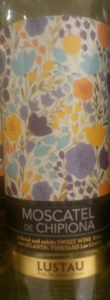 Moscatel – usually made in the nearby region of Chipiona, Muscat of Alexandria (which is the main grape used) is known for its floral and grapey characteristics, and in this fortified wine these are magnified to great effect alongside lovely citrus and honeyed notes. Deep brown/mahogany in colour, ultra-sweet (but less sweet than PX) but with a lovely lifted florality. Yum. Note: Moscatel isn’t synonymous with Andalucia, but some of its best incarnations are arguably from Chipiona.
Moscatel – usually made in the nearby region of Chipiona, Muscat of Alexandria (which is the main grape used) is known for its floral and grapey characteristics, and in this fortified wine these are magnified to great effect alongside lovely citrus and honeyed notes. Deep brown/mahogany in colour, ultra-sweet (but less sweet than PX) but with a lovely lifted florality. Yum. Note: Moscatel isn’t synonymous with Andalucia, but some of its best incarnations are arguably from Chipiona.
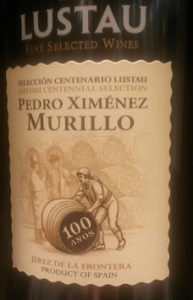 PX – these are made from Pedro Ximenez grapes which are sun dried to concentrate the sugars before partial fermentation, fortification (to 17%) and solera ageing. Deep mahogany in colour, super ripe and jammy with lots of dried fruit aromas (raisin, fig), and oodles of liquorice and toffee – I’m a big fan of these wines, they are lusciously sweet, rich and decadent, too cloying to drink too much of but absolutely gorgeous chilled and poured over Ice Cream…. I’m not kidding. Try it. Lustau is a good brand to look for.
PX – these are made from Pedro Ximenez grapes which are sun dried to concentrate the sugars before partial fermentation, fortification (to 17%) and solera ageing. Deep mahogany in colour, super ripe and jammy with lots of dried fruit aromas (raisin, fig), and oodles of liquorice and toffee – I’m a big fan of these wines, they are lusciously sweet, rich and decadent, too cloying to drink too much of but absolutely gorgeous chilled and poured over Ice Cream…. I’m not kidding. Try it. Lustau is a good brand to look for.
Finally other things you may see on labels: Labels indicating age and quality – there are VOS and VORS – which stand for Very Old Sherry and Very Old Rare Sherry. As the name suggests these are aged sherry with an average age of 20 or 30 years respectively.
Anada – meaning vintage, these are relatively rare and differ from all other sherries in that they never enter a solera system, they are wines from one particular year which are barelled and aged separately.
There are also age indicated wines which will appear as 12 YO or 15 YO but these are not for Fino or Manzanilla wines as these styles of wine with this amount of ageing will have had their Flor die off and the wines will have developed biologically aged characteristics.
That’s it for this instalment, congratulations if you made it to the end, I hope it wasn’t overly technical and that it has given a bit of an insight into the weird and wonderful world of Sherry. One thing is for sure, whether you like what you taste or not, you will have a greater appreciation of Sherry than you did before. So go on I dare you, it won’t break the bank (less than a tenner in most cases) and you might be surprised with what you find….
